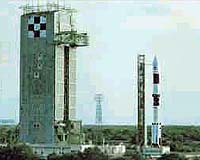 |
Huntsville AL (SPX) May 16, 2011 Engineers at NASA's Marshall Space Flight Center gave a key component of the J-2X engine a brisk workout to ensure it can withstand its extreme operating environment. The engine's fuel turbopump first stage nozzle passed the test, performing even better than expected. The J-2X is a highly efficient and versatile upper stage rocket engine that can stop and restart in space to support a variety of mission requirements. Full-scale testing begins later this summer but before then, engineers examined the longevity and durability of the engine's fuel turbopump first stage nozzle. The nozzle directs hot gas flow onto the turbine blades. The entire engine operates at extremes, but the fuel turbopump's first stage nozzle really takes a beating. Drastic thermal changes, being super chilled and then immediately super heated, stresses the metal nozzle causing it to rapidly expand and contract which eventually causes it to crack. During engine operations, this turbine nozzle is exposed to cryogenic hydrogen at -422 degrees Fahrenheit and less than two seconds after the start sequence it is hit with hot gases at 1000 degrees Fahrenheit. Apollo-era rocket scientists studied this same issue on the original J-2 engine. After a battery of tests, Apollo engineers discovered the fuel turbopump first stage nozzle cracked after dozens of starts and stops. While the part cracked, additional tests proved the engine performance and safety were not compromised. Modeling and simulation for the J-2X suggested the same issue would emerge, so designers selected a new type of nickel metal alloy for the turbopump nozzle which is less brittle and was predicted to hold up better under extreme temperature fluctuations. "We did a lot of design and analysis work on this issue to show required part life before we finalized design," said Gary Genge, J-2X turbomachinery manager at NASA's Marshall Space Flight Center in Huntsville, Ala. "We looked at making dramatic design alterations but changing the geometry of the part would have had a downstream effect we wanted to avoid. Also, the historic data hinted that wiith the improved material and minor changes, the new design might be acceptable." In total, 43 tests were conducted which simulated the actual engine start and shutdown environment. Non-destructive evaluations were performed at the beginning of every test day and no detrimental condition was ever found. "By taxing the same part over and over and carefully inspecting frequently, we know with confidence the part is very durable," said Genge. "This knowledge will save time and money in the long run because we can't inspect this area on the actual J-2X engines without disassembling the engine. This thorough test series shows we should be safe throughout the planned test series and we now have a better understanding of its longevity and structural integrity." Assembly of J-2X Engine 10001, the first engine off the production line, is in full swing at NASA's Stennis Space Center. Full-scale engine testing will begin in June. The J-2X is designed and built by Pratt and Whitney Rocketdyne of Canoga Park, Calif., for NASA's Marshall Space Flight Center in Huntsville, Ala.
Share This Article With Planet Earth
Related Links J2X tests at NASA Rocket Science News at Space-Travel.Com
 ISRO to Set Up Sub-Systems Integration Facility
ISRO to Set Up Sub-Systems Integration FacilityNew Delhi (PTI) May 16, 2011 The Indian Space Research Organisation plans to set up an advanced R and D centre in the field of spacecraft technologies in Karnataka's Chitradurga and rocket sub-systems integration facility near the spaceport of Sriharikota in coastal Andhra Pradesh. ISRO Chairman K Radhakrishnan said the space agency has got 530 acres of land in the science city in Chitradurga, where Indian Institute o ... read more |
|
| The content herein, unless otherwise known to be public domain, are Copyright 1995-2010 - SpaceDaily. AFP and UPI Wire Stories are copyright Agence France-Presse and United Press International. ESA Portal Reports are copyright European Space Agency. All NASA sourced material is public domain. Additional copyrights may apply in whole or part to other bona fide parties. Advertising does not imply endorsement,agreement or approval of any opinions, statements or information provided by SpaceDaily on any Web page published or hosted by SpaceDaily. Privacy Statement |